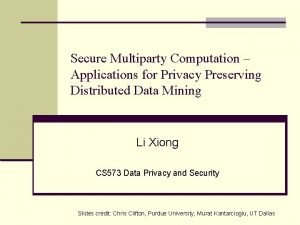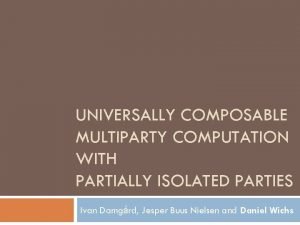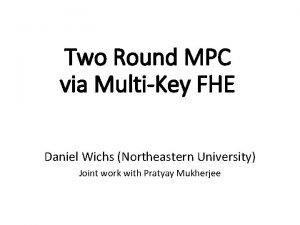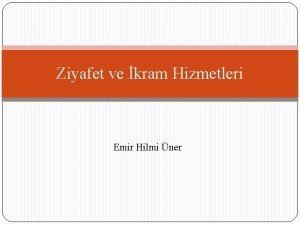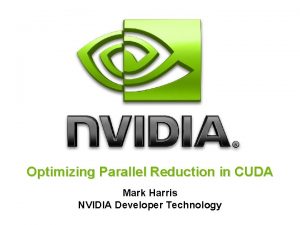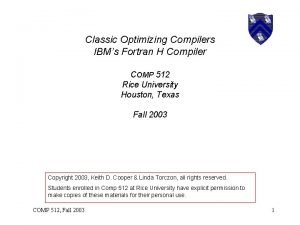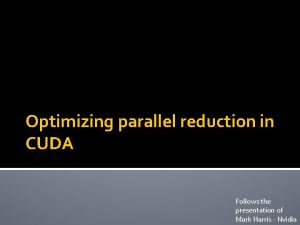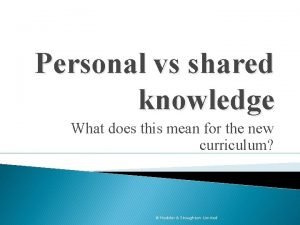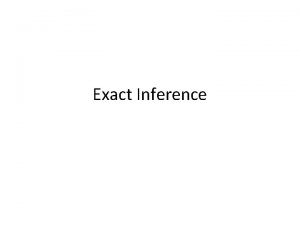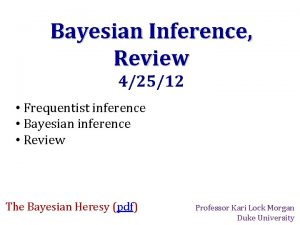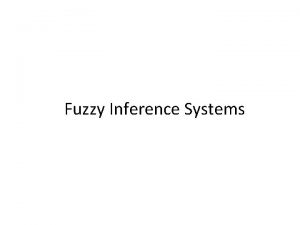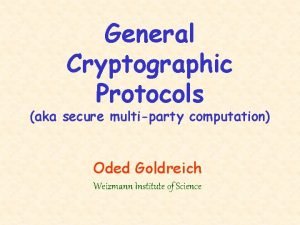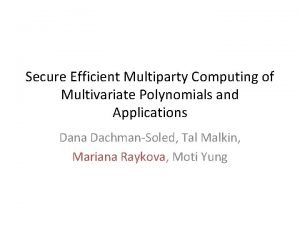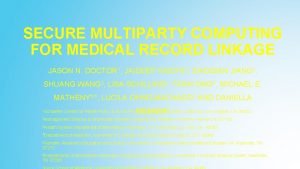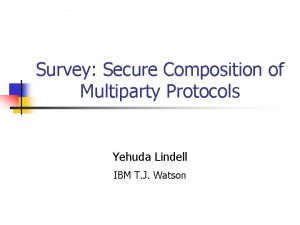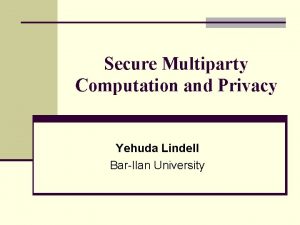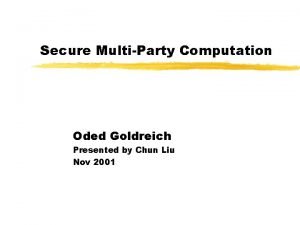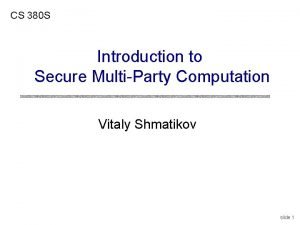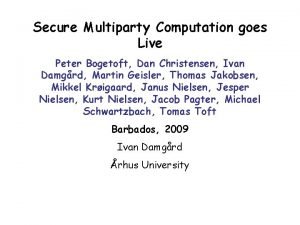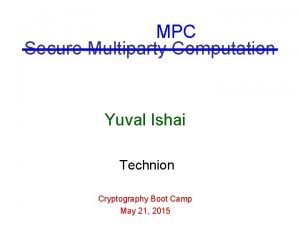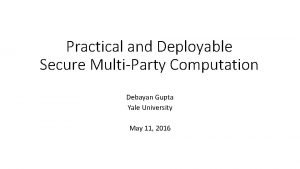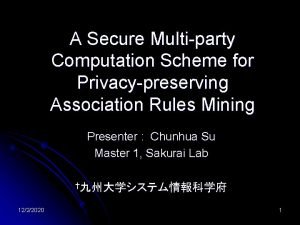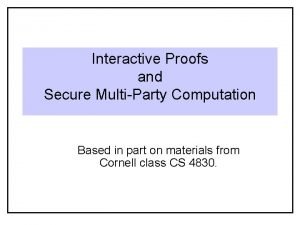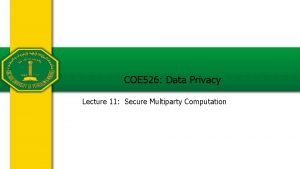PLAS 13 Knowledge Inference for Optimizing Secure Multiparty
































- Slides: 32

PLAS’ 13 Knowledge Inference for Optimizing Secure Multi-party Computation Aseem Rastogi Piotr (Peter) Mardziel Michael Hicks Matthew Hammer

PLAS’ 13 Secure Computation A B Compute f(A, B) Without revealing A to Bob and B to Alice 2/21/2021 2

PLAS’ 13 Using a Trusted Third Party A B f(A, B) A B Compute f(A, B) Without revealing A to Bob and B to Alice 2/21/2021 3

PLAS’ 13 Secure Computation Protocols A B f(A, B) Cryptographic Protocol A B Compute f(A, B) Without revealing A to Bob and B to Alice 2/21/2021 4

PLAS’ 13 Example – Joint Median Computation { A 1, A 2 }, { B 1, B 2 } Assume: A 1 < A 2 and B 1 < B 2 and Distinct(A 1, A 2, B 1, B 2) a = A 1 ≤ B 1; b = a ? A 2 : A 1; c = a ? B 1 : B 2; d = b ≤ c; output = d ? b : c; 5 2/21/2021

PLAS’ 13 Example – Joint Median Computation a = A 1 ≤ B 1 ; b = a ? A 2 : A 1 ; c = a ? B 1 : B 2; d = b ≤ c; output = d ? b : c; Secure Computation 2/21/2021 6

PLAS’ 13 Performance Optimization • Cryptographic protocols prohibitively expensive • Performance Optimization [F. Kerschbaum, CCS’ 11] – Parties can infer some intermediate values eventually • Once they know the output – Revealing these early does not compromise security* – Offload computation over known data to local hosts * In a semi-honest (honest-but-curious) threat model 2/21/2021 7

PLAS’ 13 Questions For a Secure Multi-party Computation (SMC) program: Can we infer which variables are known to a party ? Can we infer an evidence for a party’s knowledge of a variable 2/21/2021 8

PLAS’ 13 Contributions Formalization of knowledge • Formalize what it means for a party p to know a variable x • Algorithm to infer if p knows x Knowledge inference algorithm • Proof of soundness and completeness Constructive • Algorithm to construct an evidence of p’s knowledge of x knowledge inference algorithm • Proof of soundness and completeness 2/21/2021 9

PLAS’ 13 Median Example – Analysis a = A 1 ≤ B 1 ; b = a ? A 2 : A 1 ; Alice and bob know a and d c = a ? B 1 : B 2; d = b ≤ c; output = d ? b : c; 2/21/2021 10

PLAS’ 13 Median Example – Analysis from Bob’s Perspective a = A 1 ≤ B 1 ; d = (output ≠ B 1 Ʌ output ≠ B 2) Recall: Distinct(A 1, A 2, B 1, B 2) b = a ? A 2 : A 1 ; a = (output ≤ B 1) Recall: B 1 < B 2 c = a ? B 1 : B 2; d = b ≤ c; output = d ? b : c; a = true a = false b = A 2 b = A 1 c = B 2 d = true d = false output = A 2 output = B 1 output = A 1 output = B 2 A 1 ≤ B 1 ∧ A 2 ≤ B 1 A 1 ≤ B 1 ∧ A 2 > B 1 A 1 > B 1 ∧ A 2 ≤ B 1 A 1 > B 1 ∧ A 2 > B 1 2/21/2021 11

PLAS’ 13 Optimized Joint Median Computation a = A 1 ≤ B 1 ; b = a ? A 2 : A 1 ; c = a ? B 1 : B 2; d = b ≤ c; output = d ? b : c; Secure Computation 2/21/2021 12

PLAS’ 13 Formalization of Knowledge Party p knows x if: x can be uniquely determined by p’s inputs I and outputs O Two program executions that agree on I and O, also agree on x 2/21/2021 13

PLAS’ 13 Knowledge in Median Example Let states σ map program variables to values a = A 1 ≤ B 1 ; b = a ? A 2 : A 1 ; c = a ? B 1 : B 2; d = b ≤ c; output = d ? b : c; Bob knows a, if for all final states σ1 and σ2 s. t. • σ1[B 1] = σ2[B 1], • σ1[B 2] = σ2[B 2], and • σ1[output] = σ2[output], we have, • σ1[a] = σ2[a] 2/21/2021 14

PLAS’ 13 Knowledge Inference Algorithm Compute postcondition of the program Sound approximation of final program states 2/21/2021 15

PLAS’ 13 Example Postcondition for Median a = A 1 ≤ B 1 ; b = a ? A 2 : A 1 ; c = a ? B 1 : B 2; d = b ≤ c; output = d ? b : c; ϕ 1 = (A 1 ≤ B 1) ∧(a = true) ∧(b = A 2)∧(c = B 1)∧(b ≤ c)∧(d = true)∧(output = b) ϕ 2 = (A 1 ≤ B 1) ∧(a = true) ∧(b = A 2)∧(c = B 1)∧(b > c)∧(d = false)∧(output = c) ϕ 3 = …, ϕ 4 = … φmedian = ϕ 1 V ϕ 2 V ϕ 3 V ϕ 4 2/21/2021 16

PLAS’ 13 Knowledge Inference Algorithm Recall: we need to prove a Compute postcondition of the program property of any two program runs Use self-composition to simulate two program runs 2/21/2021 17

PLAS’ 13 Self Composed Median Example a = A 1 ≤ B 1 ; b = a ? A 2 : A 1 ; c = a ? B 1 : B 2; d = b ≤ c; output = d ? b : c; a’ = A’ 1 ≤ B’ 1; φself-composed = φmedian ∧ φ’median b’ = a’ ? A’ 2 : A’ 1; c’ = a’ ? B’ 1 : B’ 2; d’ = b’ ≤ c’; output’ = d’ ? b’ : c’; 2/21/2021 18

PLAS’ 13 Knowledge Inference Algorithm Compute postcondition of the program Use self-composition to simulate two program runs Derive knowledge formula and solve using SMT solver 2/21/2021 19

PLAS’ 13 Deriving Knowledge Formula a = A 1 ≤ B 1 ; b = a ? A 2 : A 1 ; Does Bob know a ? c = a ? B 1 : B 2; d = b ≤ c; output = d ? b : c; a’ = A’ 1 ≤ B’ 1; φmedian ∧ φ’median b’ = a’ ? A’ 2 : A’ 1; ∧ B 1 = B’ 1 ∧ B 2 = B’ 2 c’ = a’ ? B’ 1 : B’ 2; ∧ output = output’ d’ = b’ ≤ c’; output’ = d’ ? b’ : c’; 2/21/2021 ⇒ a = a’ 20

PLAS’ 13 Solving Using SMT Solver φmedian ∧ φ’median∧ A 1 = A’ 1 ∧ A 2 = A’ 2∧ output = output’ ⇒ a = a’ Valid ? SMT Solver Yes Bob knows a 2/21/2021 No Depending on completeness of postconditions Bob may / does not know a 21

PLAS’ 13 Properties of Knowledge Inference • Soundness – If algorithm returns p knows x, then p and x satisfy the formal definition of knowledge • Completeness – If p and x satisfy the formal definition of knowledge, then algorithm returns p knows x – Loop-free language (SMCs do not admit loops) 2/21/2021 22

PLAS’ 13 Constructive Knowledge Inference • Infer an evidence for p’s knowledge of x • Evidence is a formula for x in terms of p’s input and output variables 2/21/2021 23

PLAS’ 13 Constructive Knowledge Inference Algorithm Formulate knowledge as an invariant of the program Use template based verification to infer the invariant (Srivastava et. al. , PLDI’ 09) 2/21/2021 24

PLAS’ 13 Setting up Constructive Knowledge Inference Does Bob know a ? (A 1 < A 2 ∧ B 1 < B 2 ∧ Distinct(A 1, A 2, B 1, B 2)) a = A 1 ≤ B 1 ; b = a ? A 2 : A 1 ; c = a ? B 1 : B 2; d = b ≤ c; output = d ? b : c; Variables in τ ϵ { B 1, B 2, output } assert(a = τ) 2/21/2021 25

PLAS’ 13 Setting up Constructive Knowledge Inference Does Bob know a ? (A 1 < A 2 ∧ B 1 < B 2 ∧ Distinct(A 1, A 2, B 1, B 2)) a = A 1 ≤ B 1 ; b = a ? A 2 : A 1 ; c = a ? B 1 : B 2; Candidate predicates for τ: d = b ≤ c; output = d ? b : c; { v 1 op v 2 | v 1, v 2 ϵ { B 1, B 2, output }, op ϵ { <, ≤, >, ≥, =, ≠ } } assert(a = τ) 2/21/2021 26

PLAS’ 13 Constructive Knowledge Inference Algorithm • Derived from template-based verification • Given (m, n), searches solutions in DNF(m, n) • Efficient search: O(|Q|m + |Q|n) queries to SMT solver – As opposed to naïve O(|Q|mn) 2/21/2021 27

PLAS’ 13 Constructive Knowledge Inference for Median φpre = A 1 < A 2 ∧ B 1 < B 2 ∧ Distinct(A 1, A 2, B 1, B 2) a = A 1 ≤ B 1 ; b = a ? A 2 : A 1 ; c = a ? B 1 : B 2; d = b ≤ c; output = d ? b : c; a = output ≥ A 1 (for Alice) a = output ≤ B 1 (for Bob) d = output = A 1 V output = A 2 (for Alice) d = output ≠ B 1 Ʌ output ≠ B 2 (for Bob) 2/21/2021 28

PLAS’ 13 Properties of Constructive Knowledge Inference • Soundness – If algorithm infers a formula τ for party p and variable x, then x = τ at the end of the program – Moreover, p can compute τ from its inputs and outputs • Completeness – Similar to the completeness of verification techniques – If a solution τ exists in the template structure, our algorithm finds it 2/21/2021 29

PLAS’ 13 Connection to Information Flow Declassification Policies • Knowledge Inference similar to deciding delimited release [Sabelfeld et. al. , ISSS’ 04] • Constructive knowledge inference similar to deciding required release [S. Chong, CSF‘ 10] • See our paper for more details ! 2/21/2021 30

PLAS’ 13 Contributions Formalization of knowledge • Formalize what it means for a party p to know a variable x • Algorithm to infer if p knows x Knowledge inference algorithm • Proof of soundness and completeness Constructive • Algorithm to construct an evidence of p’s knowledge of x knowledge inference algorithm • Proof of soundness and completeness 2/21/2021 31

PLAS’ 13 Ongoing Work • Core calculus for writing M 3 PC program – Formal type-directed translation to target protocol – Translation exists for all well-typed programs – Source and target semantics preserve knowledge • Next step: Given inferred knowledge facts, automatically generate optimal M 3 PC programs 2/21/2021 32
 Secure multiparty computation
Secure multiparty computation Multiparty computation
Multiparty computation Two round multiparty computation via multi-key fhe
Two round multiparty computation via multi-key fhe Plas dol y moch
Plas dol y moch Denkstatt enertec
Denkstatt enertec Ziyafet sözleşmesi
Ziyafet sözleşmesi Plas dol y moch
Plas dol y moch Porthpean outdoor education centre
Porthpean outdoor education centre Plas gwynant outdoor education centre
Plas gwynant outdoor education centre B plas
B plas Much woolton primary school
Much woolton primary school Secure knowledge management
Secure knowledge management How is economizing different from optimizing?
How is economizing different from optimizing? Syncthreads
Syncthreads The fortran optimizing compiler
The fortran optimizing compiler Optimizing parallel reduction in cuda
Optimizing parallel reduction in cuda Optimizing patient flow
Optimizing patient flow Knowledge creation and knowledge architecture
Knowledge creation and knowledge architecture Shared knowledge vs personal knowledge
Shared knowledge vs personal knowledge Shared and personal knowledge
Shared and personal knowledge Contoh shallow knowledge dan deep knowledge
Contoh shallow knowledge dan deep knowledge Gertler econ
Gertler econ Knowledge shared is knowledge squared
Knowledge shared is knowledge squared A posteriori knowledge is knowledge that is known by
A posteriori knowledge is knowledge that is known by Knowledge shared is knowledge multiplied interpretation
Knowledge shared is knowledge multiplied interpretation Street knowledge vs book knowledge
Street knowledge vs book knowledge Vem räknas som jude
Vem räknas som jude Hur stor skarns är det för ett barn att få cancer
Hur stor skarns är det för ett barn att få cancer Jag har nigit för nymånens skära text
Jag har nigit för nymånens skära text Sju för caesar
Sju för caesar Boverket ka
Boverket ka Ledningssystem för verksamhetsinformation
Ledningssystem för verksamhetsinformation Novell typiska drag
Novell typiska drag
